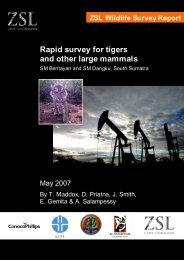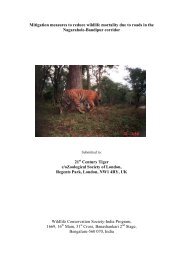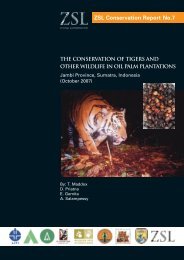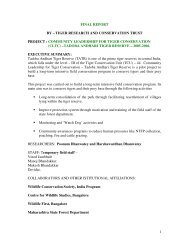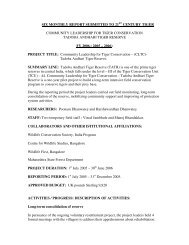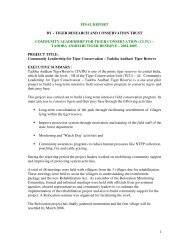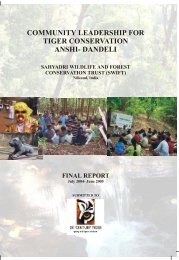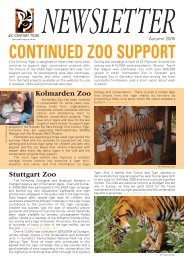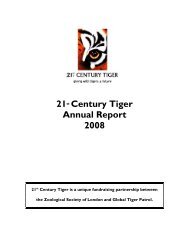WCS long term research final report 2006 - 21st Century Tiger
WCS long term research final report 2006 - 21st Century Tiger
WCS long term research final report 2006 - 21st Century Tiger
You also want an ePaper? Increase the reach of your titles
YUMPU automatically turns print PDFs into web optimized ePapers that Google loves.
person at close range, in which case she would likely aggressively protect her cub.<br />
Hazing the tigress was ineffective because she killed dogs unpredictably over a large area<br />
in three different towns and surrounding farms. However, because she was with a cub,<br />
translocation was also out of the question. Thus, it was decided to capture the tigress, fit<br />
her with a radio-collar and monitor her intensively, using pyrotechnics to frighten her<br />
when she approached human habitations. The tigress was captured on 24 January and<br />
was surprisingly in good physical condition. We estimated her age to be 11-14 years old<br />
based on very worn and stained teeth.<br />
A team of two people (one from Inspection <strong>Tiger</strong> and one from <strong>WCS</strong>)<br />
immediately began intensive monitoring. The intension was to at best, through negative<br />
conditioning, teach the tigress and cub to avoid preying on domestic animals, or at worst,<br />
prevent the pair from preying on domestic animals until the cub became independent and<br />
the mother could be translocated. Prey densities were extremely low in the area so in<br />
addition to negative conditioning, the pair was fed sika deer on three occasions. The deer<br />
were placed in the forest in close proximity to the tigress and far from human habitations.<br />
Every attempt was made to reduce the amount of human scent and tracks at the feeding<br />
site. <strong>WCS</strong> personnel worked with Inspection <strong>Tiger</strong> for approximately one month to train<br />
their personnel in radiotelemetry techniques. We then loaned Inspection <strong>Tiger</strong> a<br />
telemetry receiver and antenna so that they could continue monitoring.<br />
The pair was hazed with rockets from farms on five occasions. The immediate<br />
effect was that they left the area, but there was little apparent <strong>long</strong>-<strong>term</strong> effect, i.e., the<br />
depredations continued through the winter. This was likely, in part, because there was<br />
little wild prey in the area. At the time of this writing, Inspection <strong>Tiger</strong> <strong>report</strong>ed that they<br />
had not heard a signal for over two months, but admitted that they had monitored<br />
infrequently. Reports from locals suggested that the tigress was still in the area, but<br />
depredations had ceased, perhaps because small prey animals such as badgers and<br />
raccoon dogs become available in summer.<br />
This was a difficult situation with no good solution because of the presence of the<br />
cub. The tigress’s behavior was extremely bold and local people were very upset. Our<br />
course of action was expensive, labor intensive, and while it likely prevented a number of<br />
depredations, ultimately it did not seem to change her behavior. However, with wild prey<br />
nearly non-existent in the area, the tigress had little choice but to prey on domestic<br />
animals. Our presence did alleviate local concerns and, through discussions with local<br />
people, officials, and press, brought to light the problems associated with heavy poaching<br />
of prey in the area.<br />
3. On 9 March <strong>2006</strong>, <strong>WCS</strong> received a <strong>report</strong> of two emaciated tiger cubs at a<br />
logging camp about 50 km north of Terney. Nikolai Rybin and Vladimir Melnicov<br />
responded to the scene (both Miquelle and Goodrich were out of the country). They<br />
found two emaciated tiger cubs that were about five months old. The cubs were weak<br />
enough so that they captured the cubs by hand and transported them to Terney in the cab<br />
of a pick-up truck. We held the cubs for four days, during which time the condition of<br />
one rapidly improved while the condition of the other deteriorated. Inspection <strong>Tiger</strong><br />
collected the cubs and transported them to Vladivostok, where presumably they would<br />
receive veterinary treatment. The weaker cub died en route to Vladivostok. The<br />
remaining cub was sent to a zoo.<br />
8




